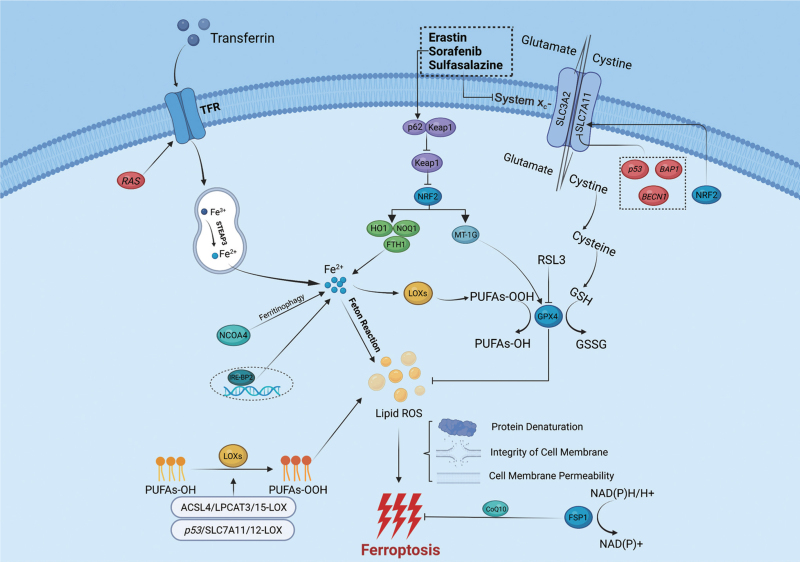Figure 1.
Molecular mechanisms of ferroptosis and key regulatory pathways. Ferroptosis is directly triggered by iron-dependent lipid peroxidation, through three possible mechanisms: (1) denaturation of related proteins on the cellular membrane; (2) disruption of the integrity of the cellular membrane; and (3) increased permeability of the cellular membrane. Lipid alcohols are oxidized to lipid hydroperoxides in a reaction mediated by LOXs, and eventually participate in lipid peroxidation. Lipid peroxidation requires the Fenton reaction and the overreaction of LOXs; simultaneously, GPX4 can prevent lipid peroxidation by consuming two molecules of GSH. GSH enters the cell through a process mediated by system xc−. Iron is transported to TFR by transferrin, then imported into the cell by TFR, and eventually converted to Fe2+ in endosomes. Subsequently, Fe2+ participates in the Fenton reaction and the synthesis of lipid peroxidation-related enzymes such as LOXs. ACSL4: Long-chain fatty acid–coenzyme A (CoA) ligase 4; BAP1: Breast cancer susceptibility gene 1 (BRCA1) associated protein 1; BECN1: Beclin 1; CoQ10: coenzyme Q10; FSP1: Ferroptosis suppressor protein 1; FTH1: Ferritin heavy chain 1; GPX4: Glutathione peroxidase 4; GSH: Glutathione; GSSG: Oxidized glutathione; HO1: Heme oxygenase-1; IRE-BP2: Iron responsive element binding protein 2; Keap1: Kelch-like ECH-associated protein 1; LOXs: Lipoxygenases; LPCAT3: Lysophospholipid-acyltransferase 3; MT-1G: Metallothionein-1G; NAD(P)H: Nicotinamide adenine dinucleotide; NCOA4: Nuclear receptor coactivator 4; NQO1: Quinone oxidoreductase 1; NRF2: Nuclear factor erythroid 2-related factor; PUFAs: Polyunsaturated fatty acids; ROS: Reactive oxygen species; SLC3A2: Solute carrier family 3 member 2; SLC7A11: Solute carrier family 7 member 11; STEAP3: Six transmembrane epithelial antigen of prostate 3; TFR: Transferrin receptor.

